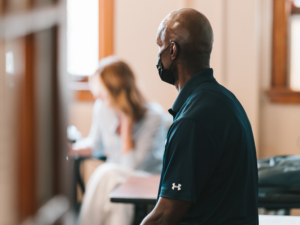How Minecraft is Teaching a Generation About Teamwork & the Environment
By Reese Jones
Minecraft, as it stands, has sold around twenty million copies across multiple platforms. It’s arguably one of the most successful games of all time, and a demonstration of the fact that videogames do not have to be sexually charged gore-fests in order to be accepted by gamers en masse. Summarily, it’s a game in which you are placed in a natural, procedurally-generated environment, and you must cut down trees, mine stone and ore, and generally manipulate your environment to build a home for yourself or go on a journey.
Its building mechanic is simple – break a block, and most of the time, you’ll get a block to place. Placing blocks becomes a LEGO-esque activity, and immediately the game’s appeal to the world’s youth is obvious. But it’s not just about allowing them to put things together however they like – Minecraft has the potential to teach children quite a considerable amount about interacting with others, and how to treat their environment.
In terms of interacting with other children, Minecraft sets down very clear rules – largely, that there are none, and just like in real life, these children must choose to work in teams, despite the fact that being aggressive or selfish may look like the immediately easier option. A house is built faster with four kids working together, and the game becomes a lot easier once night falls (when the monsters appear, furthering its appeal and relevance to an age bracket still scared of the dark) when those four are guarding each other, as well as themselves.
It’s also not a bad way to teach each child about how precious and finite the environment and its resources are. While Minecraft will extend to eight times the earth’s surface area (with each block seen as a metre cubed in real life), all resources are finite. Iron ore does not re-spawn, and neither does coal. Students have the choice of either going further and further out to get resources, or to create sustainable sources of energy and other blocks and items themselves.
This is completely feasible – farms, using pistons and other mechanical systems to automate resource collection, and none of it too complicated for a child to understand. The first stages of their lives, through Minecraft, now feature extensive teaching in why scouring planet Earth for all possible fossil fuels might be worse than simply creating a sustainable forest and opting for charcoal over coal.
There is an figurehead in the Minecraft community who goes by the title of the “Minecraft Teacher.” Taking classes of elementary school children in the United States, the Minecraft Teacher uses the game to teach children about working together, solving problems, and even exploring their engineering talents. What are the best ways to build a house? Creativity is encouraged, and there are no wrong answers, however the world of Minecraft does have specific consequences for unethical behaviour – destroying a house leaves you unprotected, and destroying the creations of other players will leave you ostracised.
Basic concepts of inclusion and tolerance are instilled in youngsters, through a videogame created by a single person. Lessons about the world, its resources, its people and how best to treat that environment, are transferable into friendships with other children who play the game, and also lessons that are placed in front of the child for them to engage with. Videogames have become the new television for so many children, and Minecraft takes this fact and the popularity of LEGO, then combines them with sociological and ecological concepts and allows kids to interact with them at their own (often youthful and therefore passionate) pace. It’s an astonishing achievement and one that every child should be allowed to engage with, should they choose to. That is, if they can wrest the controls away from enraptured adults.
Reese Jones is a tech and gadget lover, a die-hard fan of iOS and console games. She started her writing venture recently and writes about everything from quick tech tips, to mobile-specific news from the likes of O2, to tech-related DIY. Find more about her and her work at Reese+ and tweet her @r_am_jones.




Steve Fiore
Thanks for sharing this. It seems to be a promising way of thinking about how Minecraft (and related games) can be used. But is there any empirical support for the claims that it teaches teamwork, inclusion, tolerance, or problem solving?
Garth
MineCraft is used a ton in my class. Students use it to create historical worlds we are learning about with students from another school 45 miles away. They then use a green screen to take us on a virtual tour of their historical world and explain the connections to content. See an example: http://www.teachersfortomorrow.net/1/post/2012/03/minecraft-gaming-in-middle-school.html
And final copies at http://dgh.wikispaces.com/Projects
Great post.
Scott Meech
Can we include this blog post in our conference booklet? We will give all attributes/credit.
Scott Meech
Can we include this blog post in our conference booklet? We will give all attributes/credit.
Sorry as I posted from iPhone too quickly on last comment. Thank You.
minecraft server
Good information!
Make more of these topics :)
matthew
good job.
matthew
i am trying to get minecraft in school:Team work in this game if you are in a minecraft survival server it is best to have someone to help you or to work with you to survive the world get ores and food grow a farm or be a animal farmer, you get to be who you want to be .
Leihvillegas
It so good
Alex Booth
If you want to learn about the envirornment in a sand box game then Eco Global Survival is another great title to do this. It has pollution and wildlife that are all fragile and require balancing with the players development through the ages--worth checking it out